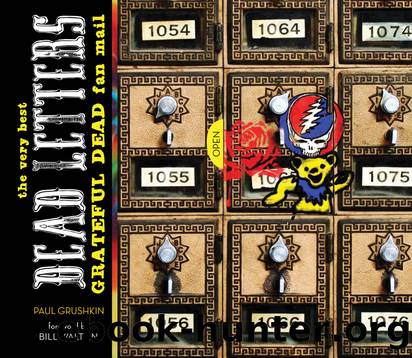Dead Letters by Paul Grushkin

Author:Paul Grushkin
Language: eng
Format: epub
Publisher: MBI
Published: 2011-11-15T00:00:00+00:00
Bears have danced on thousands of Grateful Dead tickets, T-shirts, bumper stickers, and banners. Slightly less ubiquitous is the terrapin, which first appeared on Stanley Mouse and Alton Kelleyâs cover art for the genre-stretching Terrapin Station album in 1977.
Of the 15,000 decorated ticket-request envelopes at the Grateful Dead Archive at UC Santa Cruz, nearly one-fifth are illustrated with bears. Others have terrapins, but the dancing bear is far and away the most popular graphic after the Stealie and the lightning bolt.
How did this come to be? Bearâs Choice is the answer.
Bob Thomas, creator of the iconic Live/Dead album cover art (1969), was called upon to handle Bearâs Choice in 1973. As noted previously, Bob was a longtime friend of Owsley âBearâ Stanley III (the inventor of the Deadâs early sound system and, for a time, an underground manufacturer of LSD). Thomas was the natural choice to design this Grateful Dead release, a precursor to the Dickâs Picks and From the Vault series released decades later.
On the front side Thomas riffed on the Stealie, and on the back he included what turned out to be a prescient circle of bears that many fans interpreted as dancing together, possibly marching. The Bear himself is vociferously opinionated on that subject. âI guess you may have realized by now that the bears on the album cover are not really âdancing.â I donât know why people think they are, because their positions are quite obviously those of a high-stepping march.â
Most Dead Heads would disagree. The bears always have been dancing bears, and if a bear can dance then it can move freely. Thus fans were set free to create countless new poses, color schemes, and activities for the bears.
The actual source of the bear was a thirty-six-point-type slug of a generic bear, a standardized figure in a printerâs box of lead type. Letterpress printers use such slugs to fill space on posters, flyers, supermarket advertisements, and all manner of printed pieces. Bob Thomas later told Bear that he simply found that slug in a type rack and recognized a new use for it.
The generic bear that began all this had been used in several commercial logos over the last century. One of the best known is the logo for Bear Wheel Alignment. It is an almost exact duplicate of the Grateful Dead bear, only frozen in place holding up its sign. No doubt if freed from its role, it would shake a leg all by itself, just like the Deadâs marching (a.k.a. dancing) bear.
Itâs not far-fetched to say Dead Heads saw in the bear a symbol of themselves. This creature could put on a Mardi Gras mask, doff a New Yearâs Eve hat, steer a VW van, swim in a lake (while wearing a Stealie swimsuit), or hitchhike to the next town with a lightning bolt bandana around its neck. It was all about movement. These bears, like the Dead Heads, were intent on cavorting through life. The dancing bears symbolized the fun-loving aspect of the Grateful Deadâs fans, and this helped the bandâs merchandising effort greatly.
Download
This site does not store any files on its server. We only index and link to content provided by other sites. Please contact the content providers to delete copyright contents if any and email us, we'll remove relevant links or contents immediately.
The Light of Days by Judy Batalion(1083)
The Crime Book by DK(878)
Chasing the Thrill by Daniel Barbarisi(811)
1312, Among the Ultras by James Montague(776)
The Complete Correspondence 1928-1940 by Theodor W. Adorno & Walter Benjamin(763)
Invention by James Dyson(757)
E.R. Nurses by James Patterson(732)
The Doctor Who Fooled the World by Brian Deer(725)
Till Murder Do Us Part by James Patterson(709)
If You Should Fail by Joe Moran(667)
Mind Games by Neville Southall(664)
The Reporter by Mark Paul Smith(662)
Climb by Susan Spann(651)
Surely you Ìre joking, Mr Feynman by Richard Feynman(645)
Space 2069 by David Whitehouse(636)
The Dream Architects by David Polfeldt(619)
Maradona: The Boy. The Rebel. The God. by Guillem Balagué(619)
Banking and Beyond by Unknown(569)
The 'Wolfman' by Sigmund Freud & Sigmund Freud(565)
